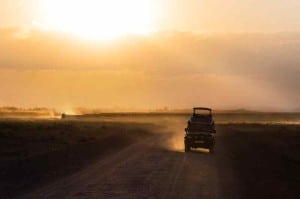
Top 5 African Safari Animals to See in Kenya
Going on a Kenya safari tour would be incomplete without seeing some of the most amazing animals in the savanna.
You’ll see giraffes snacking on Acacia trees, lions and their cubs taking an afternoon nap in the shadows and leopards chasing their prey.
Being in the natural habitats of these animals is exciting, but it can also be dangerous. Sometimes, the animals are not scared to approach vehicles, so make sure you comply with your tour guide’s orders and view the animals from afar.
For example, Kenya is one of the most sought after safari destinations because of its beautiful landscape and the animal species that call it their home.
Every animal has its own unique role in the wild, so keep reading if you’d like to learn all about the top 5 African safari animals.

The Top 5 African Safari Animals in Kenya
1. Lion
Lions are among the most impressive animal species on the planet. They’re known as the kings of the jungle and are extremely social and family-oriented. This is why you’ll rarely see a single lion – they always move around within their pride.
Lionesses are the main hunters for the pride, while male lions are responsible for the safety of the pride and surrounding territory.
Lions spend most of their time taking naps under thick tree shadows, especially after they’ve had a big meal. They also use this time to socialize, cuddle, purr and play.
For the best view of lions, make sure to have quality binoculars and camera equipment so you can spot them easily.
Fun fact: Simba means lion in Swahili.
Kenyan lions live in the Maasai Mara National Reserve.
2. Rhinoceros
Rhinos are impressive animals with no natural predators in their habitat. In Kenya, you can find two separate types of rhinos: black and white.
These African safari animals are known for their excellent sense of smell but have a very bad eyesight in return. Because they can’t see well, they use their sense of smell to detect danger or food.
Black rhinos are known for their aggressiveness even though they’re smaller in size than their white relatives. They prefer areas with dense vegetation but often move around. White rhinos, on the other hand, love the savanna, especially if there are trees, water holes and mud wallows they can cool off in. Black rhinos eat buds, leaves, bushes and smaller plants, while white rhinos are grass grazers.
Sadly, rhinos are considered endangered species because of intense poaching, so a rhino in Kenya may actually be a rare sighting. In fact, there are only 30,000 rhinos left in the entire world, of which a good number can be found in South Africa.
Rhinos in Kenya can be found in the Ol Pejeta Conservancy and the Lake Nakuru National Park.
3. Cheetah
Cheetahs are known as the fastest animals in the world and this gives them unparalleled hunting skills.
Unlike their big cat cousins, the lions, these animals don’t hang out in groups and prefer to spend their time alone relaxing on some tree. They don’t have a specific predator in the wild, but their cubs are often victims of other animals.
Also, very often, other stronger animals scavenge their prey, so cheetahs are forced to go hunting again.
They usually hunt in the early mornings, so if you want to see a cheetah, be prepared to get up early to spot one, even at a glimpse.
Kenyan cheetahs live in the Samburu National Park and the Maasai Mara National Reserve.
4. Leopard
Leopards are nocturnal creatures and do all their hunting during the night due to their impeccable night vision. During the day, they spend their time resting in the tree shadows or sleeping.
Due to their distinctive markings, leopards are able to camouflage perfectly into their surroundings. This enables them to eat their prey in peace, without attracting the attention of other predators.
They often drag their prey up the trees to keep it away from curious eyes and may even come back to the prey several times if they can’t consume it at once.
The only time you can see a leopard in company with another leopard is during mating season or when a mother takes out her cubs for a walk.
You can see leopards in Kenya’s Lake Nakuru National Park and the Maasai Mara National Park.
5. African Elephant
Elephants are the largest African safari animals you’ll see on your safari trip. But they’re also the largest land mammals in the entire world, so spotting a herd of elephants in Kenya is a real treat.
These extremely smart creatures have tight family relationships and have the miraculous ability to recognize each other. The herd is led by a single female elephant known as the matriarch, who keeps everything under control.
These animals don’t have natural predators, but poaching has reduced their number significantly. As a result, hunting elephants is prohibited by law in Kenya, as is the ivory trade.
You can find these gentle giants in Kenya’s Tsavo East and West National Parks, the Samburu National Park and the Amboseli National Park.
Conclusion
Seeing the most majestic African safari animals up close is an opportunity of a lifetime.
Maybe you know a little bit about their habits, behaviors and natural habitats from watching wildlife documentaries, but seeing these animals in person is an irreplaceable experience.
If you’re lucky, you may even get a chance to take pictures to cherish forever.
Depending on your location, accommodation and the timing of your safari tour, you may see all of these animals in one day or just some of them.
African (and especially Kenyan) safaris are undoubtedly the best way to observe these wild animals and admire their beauty.
This is why we recommend our Kenya safari tours for a complete safari experience. The duration of the tours ranges between 3 to 13 days and includes the Maasai Mara National Reserve, Lake Nakuru, Lake Naivasha, Mount Longonot, Amboseli, Nairobi and other amazing locations.
For more information, feel free to contact African Sermon Safaris, browse our offers and learn about available dates for your next Kenya safari adventure.

